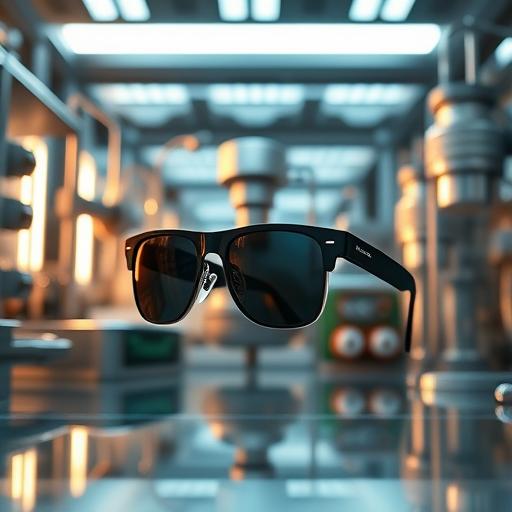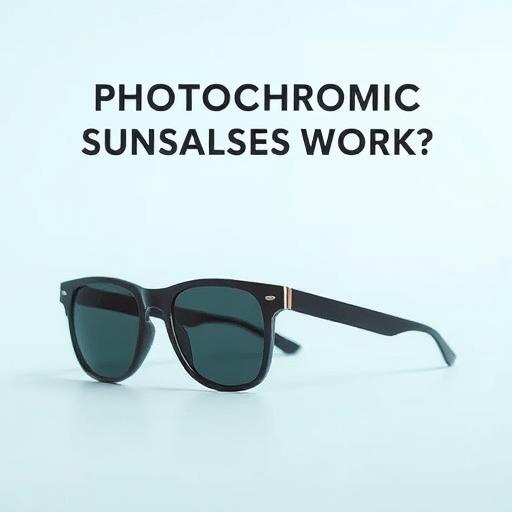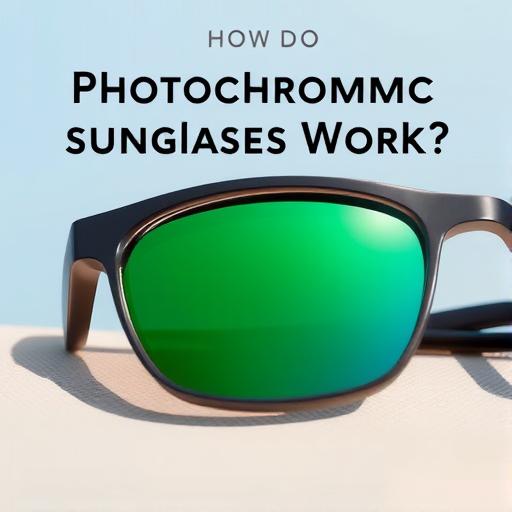How Do Photochromic Sunglasses Work

Ever wished your sunglasses could automatically adjust to changing light conditions? Photochromic sunglasses make that possible by seamlessly transitioning from clear to dark and back again. These innovative lenses, often called “transition lenses,” were first developed in the 1960s and have since become a go-to choice for those seeking convenience and eye protection. Whether you’re stepping outside on a sunny day or moving back indoors, these glasses adapt effortlessly to your surroundings. In this blog, we’ll uncover the science behind photochromic lenses, explore their benefits, and help you decide if they’re the right fit for your lifestyle.
What Are Photochromic Sunglasses?
Definition and Purpose
Photochromic sunglasses feature lenses embedded with light-sensitive molecules that react to ultraviolet (UV) light. When exposed to sunlight, these molecules trigger a chemical reaction that darkens the lenses, providing instant UV protection. Once indoors or in low-light conditions, the lenses gradually return to their clear state, ensuring optimal visibility. This adaptive technology eliminates the need to switch between regular glasses and sunglasses, making them a practical choice for everyday wear.
History of Photochromic Technology
The concept of photochromic lenses dates back to the 1960s when Corning Incorporated developed the first commercially available photochromic glass. However, it wasn’t until the 1980s that photochromic plastic lenses became widely accessible. Today, leading brands like Transitions Optical continue to innovate, offering faster transition times and a wider range of colors. Photochromic technology has evolved to cater to various needs, from prescription lenses to high-performance outdoor gear.
The Science Behind Photochromic Lenses
How Photochromic Molecules Work
The magic behind photochromic lenses lies in tiny molecules embedded in the lens material. These molecules, typically made from silver halide or organic compounds, undergo a structural change when exposed to UV light. In sunlight, the molecules rearrange, creating a darker tint that blocks harmful UV rays. When UV exposure decreases, the molecules revert to their original structure, allowing the lenses to clear up.
The Role of Ultraviolet (UV) Light
UV light is the driving force behind the photochromic effect. However, not all UV light triggers the reaction equally. Lenses darken most effectively under direct sunlight, which contains high levels of UV-A and UV-B rays. Interestingly, photochromic lenses don’t darken inside cars because windshields block most UV light. This is why some drivers prefer polarized sunglasses for better glare reduction while on the road.
Temperature’s Impact on Photochromic Lenses
Temperature can influence how quickly and effectively photochromic lenses transition. Cooler temperatures tend to enhance the darkening effect, while warmer conditions may slow the reaction. For example, you might notice your lenses darkening faster on a chilly morning compared to a hot afternoon. Although temperature fluctuations don’t significantly affect UV protection, they can impact the speed and intensity of the lens tint.
Benefits of Photochromic Sunglasses
Adaptive Convenience
One of the biggest advantages of photochromic sunglasses is their ability to adapt to different lighting conditions. Whether you’re walking from a dimly lit room into bright sunlight or vice versa, these lenses adjust automatically. This seamless transition reduces the hassle of carrying multiple pairs of glasses and ensures you always have the right level of eye protection.
UV Protection
Photochromic lenses provide 100% UV protection, shielding your eyes from harmful rays that can contribute to cataracts and macular degeneration. Unlike regular clear lenses, which offer no UV defense, photochromic lenses darken to block out excess light while still filtering out UV radiation. This dual function makes them an ideal choice for long-term eye health.
Reduced Eye Strain
Bright sunlight can cause glare and eye fatigue, especially during outdoor activities. Photochromic lenses help minimize this strain by adjusting their tint level to match the surrounding light. Whether you’re hiking, driving, or simply enjoying a day outside, these lenses provide consistent comfort and clarity, reducing the need to squint or adjust your vision constantly.

Limitations of Photochromic Sunglasses
Slow Transition Times
While photochromic lenses are convenient, they don’t transition instantly. It may take a few minutes for the lenses to fully darken in sunlight or clear up indoors. This delay can be noticeable in rapidly changing light conditions, such as moving in and out of buildings frequently.
Limited Effectiveness in Cars
As mentioned earlier, photochromic lenses don’t darken effectively inside cars because windshields filter out UV rays. If you spend a lot of time driving, you might prefer polarized sunglasses for better glare reduction. However, some photochromic lenses are designed to darken behind the wheel, so it’s worth checking the specific model.
Not Suitable for Extreme Conditions
Photochromic lenses work best in moderate light conditions. In extremely bright environments, such as snow or deserts, they may not darken enough to provide adequate protection. Conversely, in very dim lighting, they might not clear up completely, which could be inconvenient. For such situations, traditional sunglasses or specialized lenses may be a better choice.
Choosing the Right Photochromic Sunglasses
Lens Material Options
Photochromic lenses come in different materials, each with its own benefits. Glass lenses offer superior optical clarity and scratch resistance but are heavier. Polycarbonate lenses are lightweight and impact-resistant, making them ideal for sports and outdoor activities. Plastic lenses are affordable and lightweight but may scratch more easily. Your choice depends on your lifestyle and preferences.
Tint Colors and Darkness Levels
Photochromic lenses are available in various tint colors, such as gray, brown, and green, each affecting how you perceive colors and contrast. Gray tints provide neutral color perception, while brown enhances contrast, making them great for outdoor activities. The darkness level can also be customized, with some lenses offering a more subtle tint for everyday use and others providing maximum darkening for bright sunlight.
Prescription vs. Non-Prescription
Comparison table for Prescription vs. Non-Prescription
Photochromic lenses can be made for both prescription and non-prescription wearers. If you need vision correction, you can opt for prescription photochromic lenses that adjust to light while also correcting your eyesight. Non-prescription options are available for those who only need UV protection and adaptability. Consulting an optician can help you choose the best option for your needs.
Caring for Photochromic Sunglasses
Cleaning Tips
To keep your photochromic sunglasses in top condition, clean them with a microfiber cloth and a mild lens cleaner. Avoid using paper towels, harsh chemicals, or abrasive materials, as they can scratch the lenses. Always store your sunglasses in a protective case when not in use to prevent scratches and damage.

Storage Recommendations
Store your photochromic sunglasses in a cool, dry place away from direct sunlight and extreme temperatures. Prolonged exposure to heat or UV light can degrade the photochromic molecules, reducing their effectiveness over time. A hard-shell case with a soft lining is ideal for protecting your sunglasses from scratches and impacts.
Avoiding Damage
Photochromic lenses are durable but can be damaged by improper handling. Never place your sunglasses face-down on hard surfaces, as this can scratch the lenses. Avoid bending the frames, and ensure the lenses are securely fitted to prevent misalignment. Regular visits to your optician for adjustments can help maintain the lifespan of your sunglasses.
FAQs About Photochromic Sunglasses
How long do photochromic lenses take to transition?
Most photochromic lenses take about 30 seconds to a minute to darken in sunlight and a similar time to return to clear indoors. However, the exact transition time can vary depending on the lens material, temperature, and UV intensity.
Do photochromic lenses work in all light conditions?
Photochromic lenses work best in natural sunlight but may not darken as effectively in artificial lighting or behind windshields. They also don’t clear up completely indoors, which can be inconvenient in very low-light conditions.
Can I wear photochromic sunglasses while driving?
Photochromic lenses may not darken enough while driving due to windshield UV filtration. For optimal visibility on the road, polarized or photochromic lenses designed for driving may be a better choice.
Are photochromic lenses suitable for children?
Yes, photochromic lenses are a great option for children as they provide UV protection and adapt to different lighting conditions. They’re especially useful for kids who play outdoors frequently.

How long do photochromic lenses last?
With proper care, photochromic lenses can last 1-3 years before their transition speed and effectiveness start to decline. Regular cleaning and storing them correctly can extend their lifespan.
Conclusion
Photochromic sunglasses offer a smart, convenient solution for eye protection in varying light conditions. By understanding how they work, their benefits, and limitations, you can make an informed decision about whether they’re right for you. Whether you’re an outdoor enthusiast, a frequent driver, or simply someone who values ease and comfort, photochromic lenses provide a versatile and stylish option. Ready to experience the convenience of adaptive eyewear? Try a pair of photochromic sunglasses today or consult your optician to find the perfect fit for your lifestyle.
